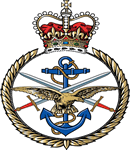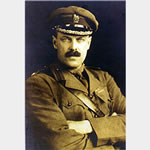Commemorated: | |||
Awards & Titles: | Knight Commander of The Most Honourable Order of the Bath Distinguished Service Order Member of Parliament 1910-1924 | ||
Early Life :
For a detailed biography see ZimFieldGuide.John Norton-Griffiths was born John Griffiths in Somerset on 13th July, 1871 the son of John Griffiths, a building contractor. At the time of his son's birth he was clerk of works at St Audries Manor Estate, West Quantoxhead. John had an unsettled youth and left home at the age of 17. After is what was cited as a wasted education he spent a year, in 1887–1888, as a trooper with the Life Guards before travelling to the colony of Natal and shortly on to Transvaal, where he worked as a 'sub-manager' at a gold mine at the age of 17. He changed his name by deed poll in 1917, taking the additional surname "Norton".
In 1901, Norton-Griffiths married Gwladys, daughter of Thomas Wood, a distillery owner (Browning, Wood & Fox). Together they had four children: Ursula (b.1903-d.1992), Peter (b.1905-d.1983) 2nd Baronet, Phoebe (b.1906-d.1976) and Michael (b.1908-d.1940). His widow Gwladys survived him, dying in 1974 at the age of 101.
Norton-Griffiths was awarded contracts to carry out major engineering projects in Africa and South America. These included work on the first 197 km of the Benguela Railway in Angola between 1903 and 1908. He was elected to Parliament in 1910 and was until 1918 the Conservative Party's MP for Wednesbury in Staffordshire. From 1918 until 1924 he was the Conservative MP for Wandsworth Central in London.
Despite being a supporter of Liverpool Football Club he became a Director of Arsenal Football Club 1928-1930 and founding member of the Royal British Legion.
Education & Career :
Norton-Griffiths attended St Paul's School, albeit briefly and is noted in most biographical noted by the lack of comment regarding his schooling and his starting work at 17, rather than any school achievements.
Service Life:
Campaigns:
- The Second Anglo-Boer War 1899-1902, South Africa.
- The First World War 1914-1918, World-wide.
| Unit / Ship / Est.: |
| Action : War Survivor |
Although many perished in times of national conflict and in the service of their country, many more survived including those interned as Prisoners of War. Stories of those who did survive are included as part of this site, especially those with high gallantry awards, those included against an external rolls of honour and those who had a distinguished career in wartime and military leaderhip.
Detail :
Extract from Everipedia .
"In 1914 at the start of the First World War, Norton-Griffiths raised the 2nd King Edward's Horse at his own expense and was commissioned major in the regiment. Using the experience from a successful engineering career, Norton-Griffiths built many fortifications for the Entente on the Western Front. An enigmatic figure, Norton-Griffiths took to touring the trenches in a battered Rolls-Royce loaded with crates of fine wines.
In early December 1914, Norton-Griffiths wrote to the War Office that his tunnelling workers could be useful for the war effort, but his letter was not acted upon. However, on 20 December 1914, German sappers placed eight mines beneath the positions of an Indian Brigade in Givenchy-lès-la-Bassée. The detonation and follow-up attack led to the loss of 800 men, and following further attacks, it was evident by January 1915 that the Germans were mining to a planned system. Lord Kitchener, contacted Norton-Griffiths on Friday, 12 February 1915, and by the end of the month eighteen "Manchester Moles" sewer men were in France as founding members of 170 (Tunnelling) Company, Royal Engineers.
In late 1916 he was sent to sabotage the Romanian oil fields ahead of a German advance. Colonel Norton-Griffiths used such techniques as dumping cement down the wells, filling tanks with nails, and emptying storage wells and then setting them on fire. He was able, almost single-handedly, to destroy seventy refineries and 800,000 tons of crude oil. General Ludendorff of the German army was later quoted as saying, We must attribute our shortages in part to him. German efforts later got some of the Romanian fields back online for the war effort, but they were never able to recover fully.
A more sceptical view of his activities was expressed by career diplomat Lord Hardinge of Penshurst. He wrote: "[In 1916] we had sent a special mission to Roumania under Col. Norton-Griffiths M.P. to destroy both the oil wells and the supplies of grain. Whether the mission succeeded may be judged by the fact that within six months all of the wells that had been destroyed were in working order and large supplies of oil and grain dispatched to Germany and Austria. But the head of the special mission received a K.C.B. for his efforts!".
He was awarded the Distinguished Service Order in 1916, knighted in 1917 and promoted lieutenant colonel in 1918 (although he had temporarily also held the rank in 1916). He was made a baronet in 1922.
After the First World War, his business and engineering career faltered, and his health began to deteriorate. His construction firm took on a contract to carry out the heightening of the Aswan Low Dam at an unrealistically low price. He was facing the possibility of financial ruin and perhaps even criminal prosecution.
On 27th September, 1930, whilst in Egypt dealing with some problems which had arisen with this dam project, Sir John took a rowboat from the beach of the Casino Hotel near Alexandria, Egypt. Sometime later, the boat was found empty, and a search party was launched. They soon retrieved Sir John's body, floating in the water, with a bullet wound through the temple. No weapon was found, but the coroner's court gave a verdict of suicide. His body was brought back to England and he was buried at Mickleham, Surrey, on 18 October 1930. He was 59 years old."
Masonic :
| Type | Lodge Name and No. | Province/District : |
|---|---|---|
| Mother : | Rhodesia No. 2479 E.C. | Zimbabwe |
| Joined : | Pen and Brush No. 2909 E.C. | London |
| Joined : | Saint Bartholomew No. 696 E.C. | Staffordshire |
| Joined : | Canada No. 3527 E.C. | London |
Initiated | Passed | Raised |
24th September 1897 | 7th January 1898 | 25th March 1898 |
Source :
The project globally acknowledges the following as sources of information for research across the whole database:
- The Commonwealth War Graves Commission
- The (UK) National Archives
- Ancestry.co.uk - Genealogy, Family Trees & Family History online
- ugle.org.uk - The records of the United Grand Lodge of England including the Library and Museum of Freemasonry
Additional Source:
- Founder Researchers : Paul Masters & Mike McCarthy
- Researcher : Bruce Littley

